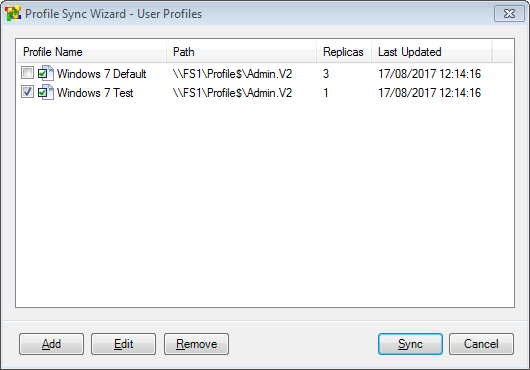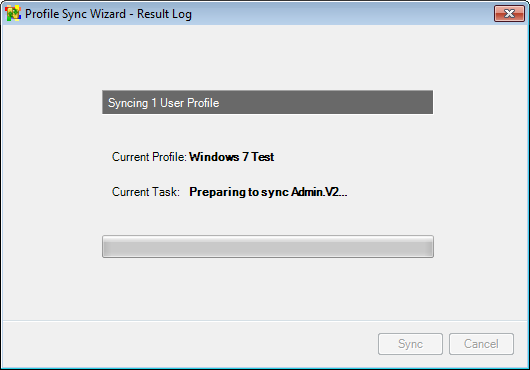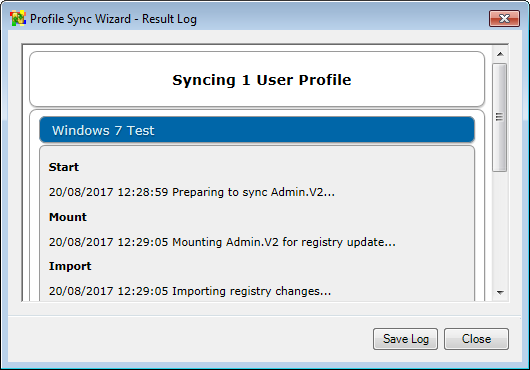
Profile Sync Wizard
In recent years, network user profiles have become a cause for concern in schools, often without the anyone being aware of it. The problem is more likely to be seen in terms of “the network being slow” or “my computer takes ages to logon”, but the issue is very often the user's profile.
We have always felt that using a 'mandatory' profile was the best choice for classroom desktops, where anyone could be using any computer. However, in recent years, our opinion has hardened considerably and we now believe it is the best choice for virtually every situation.
If you’d like to know more about the various user profile flavours, please take a look at the User Profile Types tab. Or you can accept that mandatory profiles are faster and more secure and read on!
The trade-off when using mandatory profiles was that they were seen as harder to manage. There is some truth in this, in that they require a little effort to maintain, whereas local or roaming profiles require none.
However, any time gained is soon lost dealing with the shortcomings of the latter two options. It’s also far less true since we designed the Profile Sync Wizard help simplify the process!
The Profile Sync Wizard makes it easier to update and deploy mandatory profiles by simplifying the process of converting reference user profiles into mandatory profiles. It will back-up the existing profile, reset or remove superfluous registry settings and files from the updated version and then convert and deploy it wherever it is needed.



User Profiles
On a Microsoft Windows computer, the user profile is where personal settings are saved the next time you logon. The settings may be things you choose to save, such as your bookmarks, colour scheme and wallpaper or they may be things saved for you, such as browser history, window positions and software that starts when you login. There are typically thousands of file, folder and registry changes stored in the user profile, collectively referred to as 'user state'.
There are three main types of user profile that are used to store user state:
- Local - the type of profile you get on a home computer or on a network that doesn't manage user profiles. The profile is stored locally, on the computer itself and, if you logon a different computer you will receive a fresh profile with none of your settings remembered.
- Roaming - on networked computers your profile can be set to follow you to whichever computer you use. All of the local user profile setting changes will be copied to the network when you log off, so that they can be copied to whichever computer you use the next time you logon.
- Mandatory - similar to a roaming profile, but frozen in time. You receive the same settings at any network computer you logon to, but changes are not saved when you log off, so your settings revert to the saved state the next time you logon.
Which To Use?

On the face of it, roaming profiles might appear to be a good compromise for networked computers and that may even have been true ten years ago but, these days, appearances are definitely deceptive!
The sheer quantity of data that is stored in a typical user profile, combined with the increasing reliance on wireless networks makes roaming profiles a poor choice in most circumstances, resulting in lengthy logon (and logoff) delays.
Using local profiles will result in reasonable login times, if the user has used the computer before, but creating a new profile can lead to delays, especially as some software, such as Microsoft Office, can be slow to initialise the first time it is used.
Worse still is the persistence of user state that local and roaming profiles provide has undesirable consequences, whereby malicious scripts, ransomware or malware can remain dormant and wait for the next logon to activate!
For these reasons we have come to regard mandatory profiles as the optimum solution for schools use, click the Mandatory Profiles tab above to see why.
Mandatory User Profiles FTW!
The fact that mandatory profiles make no effort to maintain user state can be viewed as a major drawback. After all, having your computer forget your favourite colour scheme, that wallpaper you like or even your preferred network printer, does not seem to be ideal on the face of it.
In practice, it is rarely an issue, because the network can be configured to work around most limitations, such that any loss of functionality is minor and more than offset by the benefits: logon/logoff time measured in tens of seconds rather than tens of minutes and improved protection from malware.
| Concern | Remedy |
|---|---|
| I will have to manually create my printer connection, web browser bookmarks and other software settings every time I logon. | No you wont. Most settings can be made to survive the process without need for user intervention - and without needing to copy thousands of files from the network, as is the case when waiting for a roaming profile to do its thing. |
| Mandatory profiles make it difficult to deploy new software because any registry settings that might be needed will be missing. It's better to let the software create the settings when the user runs it and then their profile will remember. | After installing new software, run the Profile Sync Wizard to update the user profile and settings will be in place without bothering the user at all! |
| The office staff don't like mandatory profiles, they each have their own desktop and like to retain their own settings. | Do they also like malware? Are the office staff able to spot when a web site they trust is hosting a drive-by-download attack? This is actually how ransomware found its way onto the network at two schools we assist! |
| Local or roaming profiles are easier to implement. | Easier for who? Probably not your users! |
| I'll lose my sticky notes! | Yes you will, sorry. (If you use Exchange, Outlook has them) |